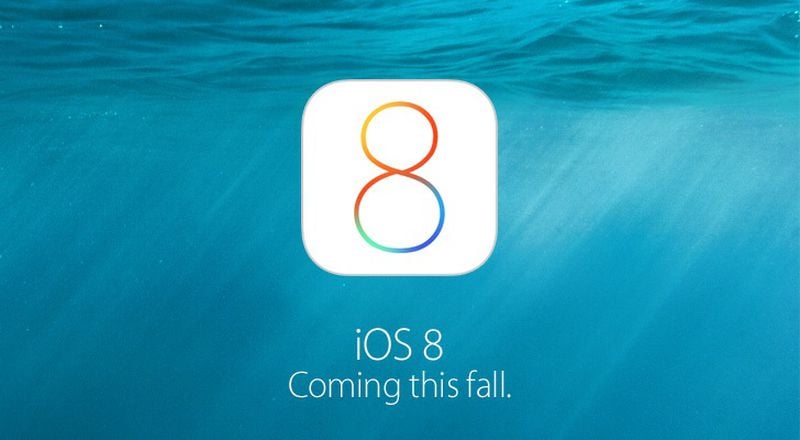
Overview
Contents
iOS 8 was unveiled at Apple's Worldwide Developers Conference in June of 2014 and launched to the public on September 17, 2014. The release for existing devices came two days ahead of the launch of the iPhone 6 and 6 Plus.
Improved integration between Apple devices, both mobile and desktop, is a major focal point of both iOS 8 and OS X Yosemite. Apple introduced several new "Continuity" features that are designed to connect the iPhone, iPad, and Mac "like never before."
AirDrop, Apple's peer-to-peer file sharing protocol, now works between iOS and Mac devices. Handoff, a newly introduced feature, works on the same sharing principles and lets users start a task on one device and instantly pick it up on another.
Along with sharing tasks with Handoff, iPads and Macs can both place and answer phone calls using the iPhone as a relay. Using this same functionality, Macs and iPads are able to receive SMS messages via the Messages app, which was previous limited to iMessages on those platforms.
Several features within iOS 8 have received major upgrades, including Notification Center. There are new interactive notifications, allowing users to quickly reply to texts, emails, and more, right within the notification banner. Apps can install widgets in the Notification Center in iOS 8, expanding its capabilities.
The Messages app has new options that let users manage (and leave) group conversations, and the app supports quick voice messages and videos. Typing within Messages and other apps is also much easier, thanks to a new QuickType predictive keyboard. Third-party keyboards can also be installed.
Apple has debuted a new iCloud service called iCloud Drive, which works similarly to Dropbox. iCloud Photo Library, a part of iCloud Drive, has been built into a redesigned Photos app to make all of a user's photos accessible on every device. Photos has also gained new editing tools, while the Camera app has a new time-lapse mode and a built-in timer.

iOS 8 includes a new "Health" app, which is designed to aggregate data collected from various health and fitness apps. Other apps, like Safari and Mail, have new looks and new features, such as gesture control for the latter.
A major new feature, Family Sharing, lets families of up to six people share apps, music, books, and more, while a revamped Spotlight feature incorporates more search options than ever before.
In addition to the above listed features, iOS 8 includes dozens of smaller unannounced changes, which we've aggregated in our iOS 8 Features Roundup.
We have also gathered up several lists of apps that take advantage of Apple's new iOS 8 features: List of apps with Touch ID integration, list of Third-Party keyboards, and list of apps with Notification Center widgets.
Latest Version
The final version of iOS 8 is iOS 8.4.1, which was released to the public on August 13, 2015. iOS 8.4.1 was a minor update that included fixes to Apple Music, overall performance improvements, and security enhancements.
Prior to iOS 8.4.1, Apple released iOS 8.4, the last major update to iOS 8. It was released on Tuesday, June 30, 2015, bringing a revamped Music app and introducing the new Apple Music service, which consists of an on-demand streaming service, the Beats 1 radio station, and Apple Music Connect, Apple's artist-centric social network.
There were other small changes introduced in iOS 8.4, including the removal of Home Sharing for music. iOS 8.4 also movies audiobooks from the Music app to the iBooks app.
Before iOS 8.4, Apple released iOS 8.3. iOS 8.3 brought a long list of bug fixes and several new features to the iOS 8 operating system, including a revamped and reorganized emoji picker with new emoji and skin tone modifiers, support for Google two-step verification when adding a Google account on iOS, new Siri languages, Siri calls via speakerphone, an updated UI that elongates the keyboard's spacebar, and a new filter option for iMessage.
Before iOS 8.3, Apple released iOS 8.2 on Monday, March 9. iOS 8.2 included support for the Apple Watch, adding a new Apple Watch app to the iPhone's home screen. It also fixed several bugs and security issues.
Prior to iOS 8.2, Apple released iOS 8.1.3. iOS 8.1.3 was a minor update that included several bug fixes like a fix for an issue that prevented some users from entering their Apple ID passwords for Messages and FaceTime, a bug that caused Spotlight to stop displaying app results, and a problem that prevented multitasking gestures from working on the iPad. iOS 8.1.3 also reduces the amount of space required to perform an iOS update and adds new configuration options for education standardized testing.
Ahead of iOS 8.1.3, Apple released iOS 8.1.2 to the public on Tuesday, December 9. A minor update, iOS 8.1.2 included a fix for disappearing ringtones and other unspecified bug fixes.
iOS 8.1.1 came before iOS 8.1.2, and was released on Monday, November 17, 2014. As a minor update, iOS 8.1.1 focused on bug fixes and performance improvements for older iOS devices like the iPhone 4s and the iPad 2.
Before iOS 8.1.1, Apple released iOS 8.1 on Monday, October 20, 2014. As the first major update to the mobile operating system, iOS 8.1 brought quite a few significant changes to iOS 8, including support for Apple Pay, new Continuity features like SMS Forwarding and Instant Hotspot, iCloud Photo Library, and the return of camera roll, along with fixes for several different bugs that caused Wi-Fi issues and prevented Bluetooth from pairing properly.
Prior to the release of iOS 8.1, Apple released iOS 8.0.2, fixing a cellular and Touch ID bug introduced with iOS 8.0.1 and fixing several additional issues, including a HealthKit bug, a problem with third-party keyboards, and more.
Issues
On September 24, 2014, Apple released iOS 8.0.1 to the public, which included bug fixes for a number of issues including a significant problem that plagued HealthKit. Early installers quickly found a major bug in the release affecting the iPhone 6 and 6 Plus, which disabled Touch ID and prevented their phones from connecting to cellular service.
Apple pulled the update approximately an hour after it was released, but not before a multitude of users had downloaded the software and encountered the cellular problem. Apple released iOS 8.0.2 shortly after with a fix, but even that update continued to cause problems for Australian users.
In addition to the temporary bugs introduced with iOS 8.0.1, some users are seeing more permanent problems with the iOS 8 update that have yet to be addressed, including battery drain and slow wi-fi speeds.
A bug with iCloud Drive and the "Reset All Settings" option causes all iCloud Drive documents to be deleted from iCloud when "Reset All Settings" is used. While these files can be recovered from a Time Machine backup, the process is tricky in Yosemite and unavailable to users without a backup. iOS 8 users should avoid using "Reset All Settings" if important documents are stored in iCloud Drive until a fix is available.
Many users experienced issues pairing an iPhone or iPad running iOS 8 to Bluetooth devices. While the problem seemed to be centered on pairing with the in-car audio systems, users reported issues with a range of Bluetooth devices like speakers, headsets, and more. The bug was fixed with iOS 8.1.
As of iOS 8.4, many of the issues in iOS 8 have been solved, and Apple has begun to focus its attention on iOS 9, the next version of iOS that's set to be released in the fall of 2015.
iOS 8 In More Detail
Continuity
OS X Yosemite and iOS 8 have been designed to work together, with several new features that increase the integration between the two operating systems.
Handoff, for example, lets a user start a task on one device and then switch to another. A person might start writing an email on the iPhone, and then pick up where they left off when sitting down at a Mac. A user can browse the web on the Mac and then continue browsing the same website on the go on the iPad.
This feature is enabled automatically, so long as all devices are signed into the same iCloud account. Handoff works with apps like Mail, Safari, Pages, Numbers, Keynote, Maps, Messages, Reminders, Calendar, and Contacts, and it can be built into third-party apps.
iPads and Macs are now able to connect directly to an iPhone's personal hotspot when it is nearby using a new Instant Hotspot feature.
Phone and SMS Messages
Integration between iOS 8 and OS X Yosemite allows a Mac or an iPad to make or receive phone calls as long as it is on the same Wi-Fi network as an iPhone running iOS 8. Incoming calls on a Mac or iPad show the caller's name, number, and profile picture, allowing users to answer or ignore calls. Making a call on an iPad or Mac can be accomplished by tapping on a phone number in Contacts, Calendar, or Safari, and the feature works with an existing iPhone and phone number.
Users are also able to receive and reply to SMS and MMS messages from a non-Apple device on both their iPads and Macs, using the Messages app. Previously text messages from a non-Apple device could only be received on an iPhone.
Notification Center
Interactive notifications have been added, allowing users to reply to texts, emails, calendar invitations, reminders, and more right within their notification banners, without having to leave an app that is in use. This feature makes it easy to quickly reply to a message or other notification without the need to switch to a completely different app. This feature even extends to some third-party apps, like Facebook, allowing users to like or comment on a status right as a notification pops up.

Apps will be able to install widgets within the Notification Center, adding new modules similar to the existing sections for Calendars and Stocks. The "Missed" tab within the Notification Center has been removed in iOS 8.
Multitasking Interface
The app switcher, or multitasking interface, is accessed by tapping twice on the home button. While this has largely remained the same, there's a new section above open apps that lists both recent contacts and favorite contacts, making it easier to initiate a phone or FaceTime call.
Messages
Messages has finally gained a much-desired feature that allows users to leave group conversations. It's much simpler to add and remove users from group conversations, and a new Messages "Do Not Disturb" mode lets users mute group conversations whenever necessary.

In group conversations, users are also able to share their locations for a set period of time via a new "Send My Current Location" button, and a new attachments section displays all of the photos and videos that have been exchanged in a specific group conversation.
The app now supports voice recordings, which can be captured using a new microphone button and sent via a swipe. Users who receive a voice recorded message can raise the phone to their ear to hear the message. Similarly, video messages can be sent in almost the same way, and watched directly within the Messages app.
Finally, it's now possible to send multiple photos or videos in a single message instead of requiring a separate message for each photo.
QuickType & Other Keyboard Options
Described as Apple's "smartest keyboard ever," QuickType is designed to offer word suggestions while typing. As a user is typing, the keyboard will provide words and phrases that a user is likely to choose next, even taking into account the different writing styles a person might use in different apps like Mail and Messages.
According to Apple, QuickType adjusts based on the person being communicated with, "because your choice of words is likely more laid back with your spouse than with your boss."
With iOS 8, Apple began allowing third-party keyboards to be installed on iOS for the first time, giving users systemwide access to popular keyboards like Swipe and Fleksy.
Photos
The Photos app has been redesigned to add a new iCloud Photo Library. Every photo and video captured is uploaded to iCloud, allowing users to access and download their photo libraries from any device. It stores photos in their original formats, including RAW files, while keeping a smaller copy on iOS devices.
iCloud Photo Library keeps photos organized into Moments, Collections, and Years, and edits that are made on a photo will be immediately uploaded to iCloud and visible on other devices.
The iCloud Photo Library feature is designed to allow people to keep their pictures in the cloud while freeing up valuable device space. Due to the increased storage many people will need in order to upload photos to iCloud Photo Library, Apple provides users with 5GB of iCloud storage for free, with 20GB available for $0.99 per month or 200GB available for $3.99 per month.
Ahead of the launch of iOS 8, Apple demoted iCloud Photo Library back to beta status and removed access to it from the golden master.
Apple is also implementing smarter search within the Photos app, making it easier to search through thousands of photos. Searches can be conducted via date, time, location, or album name, with smart suggestions for Nearby, One Year Ago, Favorites, and more.

The editing tools within the Camera app have also been revamped. With new Smart Composition tools, it's easier than ever to straighten crooked photos and create the perfect cropped image. There new Smart Adjustment tools that allow users to quickly improve lighting conditions by grouping brightness, contrast, exposure, highlights, and shadows into one quick adjustment slider. There's also a similar color adjustment tool, along with built-in filters and new access to third-party filters.
Camera
The Camera app has gained a new time-lapse video mode, which takes photos at dynamically selected intervals and then creates video depicting an accelerated sequence of the photos. The app also has new controls for exposure, thanks to a range of new manual camera APIs Apple introduced with iOS 8.
Panoramic mode was introduced for the iPhone awhile ago, but with iOS 8, it's available on the iPad. Both the iPhone and the iPad have gained a new timer mode, which lets users set a delay of three or 10 seconds before capturing an image.
iOS 8's Mail app includes new swipe gestures that let users swipe to mark an email as read or flag it for a follow up. There's also a new swipe down gesture that minimizes an email being composed to let a user view the rest of the Mail inbox, and Mail is now smarter, recognizing information like dining reservations, flight confirmations, and phone numbers, allowing it to be add to Calendar, Contacts, and other relevant apps.
Safari
The tab view that was first introduced on Safari for iPhone has been added to the iPad, displaying menu bar items in a tiled grid. A separate view accessible via a button on the top right of the bar allows users to see a view of all open tabs, both on the current device and on other nearby devices. A new sidebar displays bookmarks, Reading List, and Shared Links.
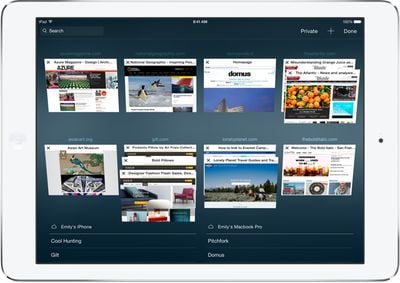
Health
Apple has introduced a new "Health" app, which functions as a dashboard that aggregates data collected from various health and fitness apps. It includes sections for Diagnostics, Fitness, Lab Results, Medications, Nutrition, Sleep, Vitals, and more, along with an Emergency Card displaying medical conditions and allergies. The Emergency Card is accessible directly on the lock screen.
Health is designed to put all of a user's heath and fitness data in one easy-to-access spot, creating a clear overview of a person's current health. It will likely integrate with several existing apps and devices, as well as the Apple Watch when it is released in early 2015.
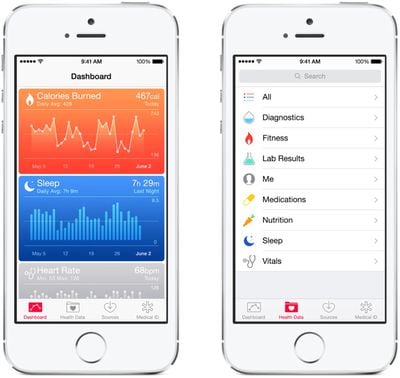
Siri
Siri can now be activated with the voice command "Hey Siri," and the voice assistant also features integration with Shazam, identifying songs upon request. It also supports streaming voice recognition, is able to purchase iTunes content, and features 22 new dictation languages.
Spotlight
Spotlight has been revamped on both iOS and OS X, and it is now able to show suggestions from the Internet, iTunes, App Store, locations nearby, and more. For example, when searching for a movie using Spotlight, it the search results will include both movie showtimes and relevant iTunes links.

Searching for a term like "Cats" will display results that include options from Wikipedia and nearby cat-related locations.
Family Sharing
iOS 8 introduces a new feature for families called "Family Sharing," which lets families of up to six people with iTunes accounts that use the same credit card share content like apps, iBooks, movies, and music.
This feature allows family purchases to be bought with the same credit card and it allows children to initiate purchases that must be confirmed by a parental device.
Family Sharing also lets families share photos, videos, a calendar, reminders, and more to keep everyone in the family connected. The feature can automatically share location between family members, letting parents keep an eye on kids, and it lets family members find lost devices.
iCloud Drive
iCloud Drive lets users store presentations, spreadsheets, PDFs, images, or any other kind of document within iCloud, making them accessible on any Mac or iOS device. It functions similarly to Dropbox, with a dedicated folder within Finder on OS X Yosemite that users can drag files to.
Edits made to a file within iCloud Drive will sync to all devices, and because iCloud Drive now allows apps to share files, a file can be accessed in one app and then manipulated in another. For example, a sketch might be started within one sketching app and then opened in a second.
iOS 8 Hidden Features
Along with the major iOS 8 features that Apple outlined both during its WWDC keynote and on its iOS 8 Overview page, iOS 8 includes dozens, if not hundreds, of little tweaks and operating system changes. We've gathered a few of the more interesting updates here, but a much more extensive list of changes can be found in our iOS 8 Features Roundup.
Battery usage by app - iOS 8 displays battery usage by app, a handy feature that will let users monitor the battery drain of specific apps, to scale back on the use of those that draw too much power during critical times.
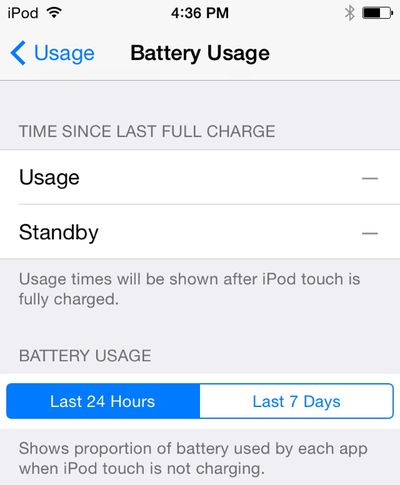
Time-Lapse mode for Camera - The Camera app has gained a new Time-Lapse mode, which captures a series of images and then compiles them into a time-lapse video. There are also new manual exposure controls, which allow exposure to be selected when taking a photo, and a self-timer mode that can be set for three or 10 seconds.
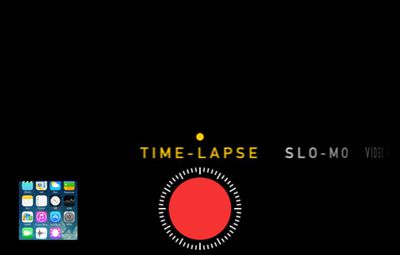
Photos - The Photos app has received new organizational options, including two albums for "Recently Added" and "Recently Deleted." The Recently Deleted section temporarily displays images that have been removed from the app in case of accidental deletion. The date and time a photo was taken is also displayed.
Send Last Location - Find My iPhone has gained a new feature that allows users to select an option to send an iOS device's last known location to Apple when a battery drains to a critical level, potentially giving Apple more tools to locate lost devices.
Location-based apps - iOS 8 displays apps for nearby stores and services on the lock screen when a user is out and about. For example, when visiting a Starbucks, an icon for the Starbucks app will appear on the screen, whether or not the app is installed.
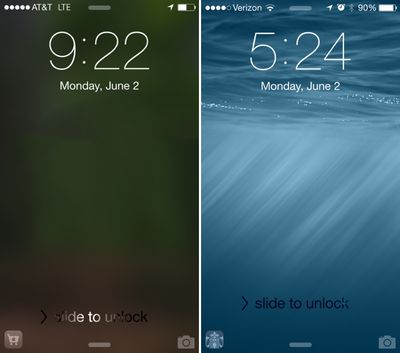
WiFi Calling - iOS will include an option for WiFi calling, allowing users to place calls over WiFi instead of cellular when connected to a WiFi network, saving minutes and data. Several carriers, including T-Mobile, have already announced support for the feature.
Grayscale mode - There are several new Accessibility options, including a new "Grayscale" mode that shifts the entire operating system into shades of black and white. There's also Improved Zoom option.
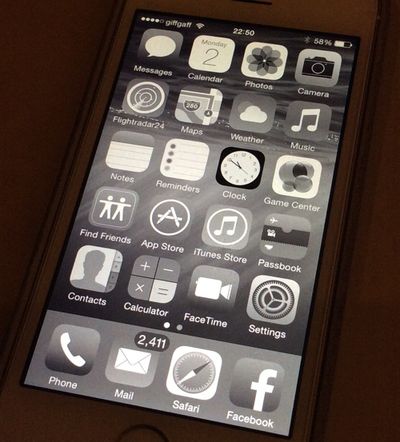
Safari credit card scanning - In iOS 8, Safari uses the camera to scan in credit card numbers when making online purchases, a faster alternative than manually entering a credit card number.
Randomized MAC addresses - iOS randomizes the MAC addresses of iOS devices when scanning for WiFi networks, which makes it more difficult for companies to track and gather location data on a customer. Each iOS device has a unique MAC address, which could previously be used for location tracking and data collection via WiFi scanning. iOS 8 uses random, locally administered MAC addresses that "may not always be the device's real (universal) address."
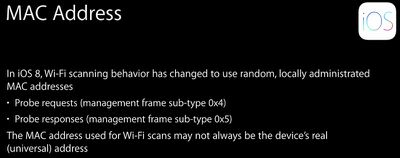
These are only a small selection of the new features that have been added to iOS 8 at this point, and to find more, make sure to check out our iOS 8 Features Roundup. iOS 8 will go through several beta iterations, which may see many of these features tweaked and could bring the introduction of additional features.
iOS 8 for Developers
Alongside improvements and additions to iOS 8 that are consumer facing, Apple released a multitude of new tools for developers. According to VP of software engineering Craig Federighi, iOS 8 includes more than 4,000 new APIs for developers.
These new APIs and tools added for developers will lead to apps that are easier to create and able to do all kinds of new things, from accessing Touch ID to integrating with one another in exciting ways. iOS 8 and its APIs are available to developers immediately, so they can begin development of apps ahead of the public release of iOS 8. Some of iOS 8's new capabilities have been demoed in a beta version of 1Password. With iOS 8, it's much quicker to both access 1Password and use the app's password-storing capabilities within other apps.
Apple has improved App Store tools available for developers, which is also a boon to consumers. For example, developers can now create app bundles, offering several apps at a discounted price. App previews have been added, letting developers add app videos to App Store descriptions, and TestFlight makes it easier than ever for developers to test apps.
When it comes to developer tools, perhaps one of the most exciting is Extensibility, a feature that lets App Store apps communicate with one another. For example, a photo editing app like VSCO is able to supply filters to the Photos app and other editing apps, and Pinterest's pinning feature has been built into Safari using Extensions.
Apple introduced a new programming language for developers, called Swift, and while this is not immediately relevant to non-developers, its ease of use makes it easier than ever to create apps for iOS. Similarly, a new Metal feature for games is highly technical, but will ultimately result in amazing graphics for future iOS games, as will new APIs and tools in the SceneKit and SpriteKit for casual games. iCloud integration is also improved, thanks to CloudKit.

Camera and photo editing apps have seen some major improvements with PhotoKit, which includes new APIs that lets developers build tools to edit photos directly within the official photos app. Camera apps now have access to full control over exposure, focus, and white balance, which means photography apps are more powerful than ever before.
HealthKit and HomeKit will see Apple working with hardware manufacturers to integrate data into various apps and services. With HealthKit, health and fitness devices and apps will be able to integrate their data into Apple's Health app, while HomeKit will unite various home automation apps. Just after the release of iOS 8, Apple found a significant bug in HealthKit and disabled apps using the service, but the issue was fixed with iOS 8.0.2.
iOS 8 How Tos and Guides
- How to Get 'Handoff' Working in OS X Yosemite and iOS 8
- How to Use iOS 8's 'Instant Hotspot' On a Mac with OS X Yosemite
- How to Use AirDrop to Share Files Between Macs and iOS Devices
- How to Enable Text Message Forwarding and Answer Phone Calls on Your Mac
- How to Enable Family Sharing in iOS 8 and OS X Yosemite
- iCloud Photo Library: What You Need to Know
iOS 8 App Lists
What Followed
iOS 8 was succeeded by iOS 9, which was released to the public on September 16, 2015.

